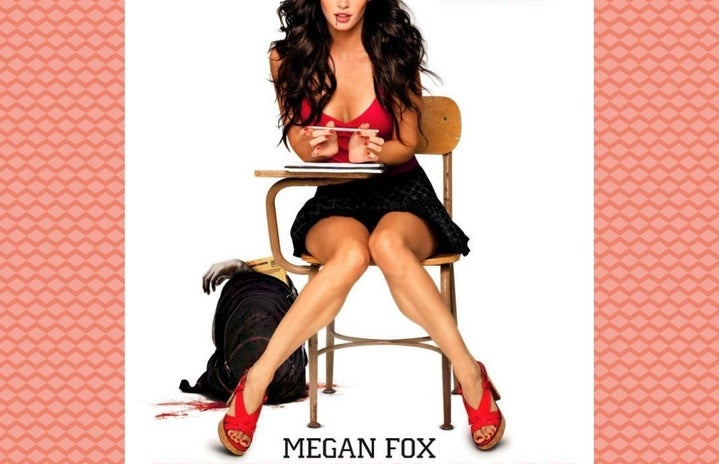“Hell is a teenage girl.” The tongue-in-cheek first line of the 2009 dark comedy horror film “Jennifer’s Body” sets up a contentious dichotomy from the very first moment. There’s the way women might interpret this line, the way writer Diablo Cody intended it to be interpreted, as a clever acknowledgement of sexist predispositions mixed with a sardonic declaration of power. And then there’s the way predominantly male audiences interpreted it. After all, this film was always stuck between two opposing forces: the women it was made for, and the men who were told it was made for them. The “Jennifer’s Body” marketing campaign was an absolute failure that doomed the film from the start.
Plot
At its core, “Jennifer’s Body” is a movie about women. It focuses on the close friendship between Needy Lesnicki (Amanda Seyfried) and Jennifer Kent (Megan Fox), two high school students. While Needy keeps a low profile, really only spending time with Jennifer and her boyfriend Chip, Jennifer is the most popular girl at school. After a fire breaks out while the two are attending a dive bar set for the indie band Low Shoulder, Jennifer undergoes a traumatic event that changes her. Afterwards, Jennifer starts killing boys in her small hometown of Devil’s Kettle. As Jennifer and Needy’s friendship becomes strained, Jennifer continues on her killing spree until things reach a climactic head.
“Jennifer’s Body” takes on a lot of important topics. There’s allusions of sexual assault in Jennifer’s trauma. There’s femininity in her performance of gender and the ways she maintains it after the inciting event. There’s close female friendships and the fluidity of sexuality in Needy and Jennifer’s love for each other, and in such iconic lines as Needy’s “I thought you only murder boys?” followed by Jennifer’s “I go both ways.”
With all these things in mind, it seems like “Jennifer’s Body” was bound for success. So what went wrong?
Marketing Misfires
To understand why “Jennifer’s Body” was marketed a certain way, it’s necessary to understand the context. “Transformers” was released in 2007. It was the first film for which Megan Fox would become famous, but it’s also part of a long tradition of Fox being over-sexualized on-screen. Directed by Michael Bay, the man who years prior had Fox dancing in a bikini under a waterfall in “Bad Boys II” at the age of 15, further exploited her in the new franchise. The infamous sexy-woman-fixes-car scene, complete with camera pans over Fox’s entire body, is just the tip of the iceberg.
With the popularity of Fox in that project, studios sought to capitalize off of her name and persona alone. For “Jennifer’s Body,” this meant Fox would be the driving force behind marketing. Particularly, her attractiveness would be top priority. Promotional materials put her, scantily clad and posed provocatively, front and center on everything to the point where co-lead and narrator Seyfreid is virtually nowhere to be found.
But it’s not just that they used Megan Fox to bring in audiences; it’s how they used her. As established, “Jennifer’s Body” is a dark-horror-comedy-satire with feminist sensibilities and a lot to say, but the film was marketed toward predominantly teenage boys. Despite warnings from writer Cody and director Karyn Kusama, the studio used Fox’s status as a sex symbol to market a movie very different from the one they were actually promoting. In a particularly offensive marketing idea that never actually came to fruition, it was proposed that Fox would host an amateur pornography site to create buzz for the movie.
I’ve discussed before how a trailer can make or break a movie, and though the “Jennifer’s Body” trailer puts in some work to establish its intentions, it still leans a little too heavily on horror conventions, a move that will likely leave genre fans disappointed. Also, the inclusion of the three-second clip of two girls about to kiss feels more gratuitous than representative, but maybe that’s just me.
Marketing the movie as a fantasy set through the male gaze was an irreparable mistake. Male moviegoers gathered to watch two hours of Megan Fox being sexy with a jump scare or two, and found instead a gory, calculated display of feminist bravado complete with Fox growing fangs and ripping boys to shreds, not taking her clothes off or seductively examining a car engine.
Legacy
At the time, “Jennifer’s Body” flopped both critically and at the box office. With a whopping 44% Rotten Tomatoes score and 34% audience rating when it came out, it’s safe to say audiences were not impressed. Though famous film critic Roger Ebert gave one of the more positive reviews with three out of five stars, he still belittled the film’s message, reducing it to “‘Twilight’ for boys.”
Today, it has become something of a cult classic. Critics are changing their minds, as the film now shows up on horror movie lists and is talked about frequently in feminist circles. The consensus is one I agree with: “Jennifer’s Body” would have been a hit if it was released today. Though there’s something compelling about the timelessness of its story, there’s no denying that a post-#MeToo landscape would have been the perfect contemporary for the story Cody was trying to tell.
At the end of the day, “Jennifer’s Body” is a revenge story — one that would fit in nicely next to Emerald Fennell’s “Promising Young Woman.” While the former’s true intentions were hidden throughout its marketing campaign, the latter was up front about exactly what kind of havoc Carey Mulligan’s protagonist was going to wreak.
Though 2009 wasn’t ready for the feminist masterpiece that is “Jennifer’s Body,” I’m endlessly glad we have it now. Not only is it a brilliantly fun and engaging watch and a necessary parallel to Fox’s mistreatment in the film industry throughout her career, but it really serves as a Rorschach test for where we are as a society. And it’s the kind of film you could watch on a first date to gauge the other person’s reaction. If they fall in line with 2009 critics, I think you might have a problem.


